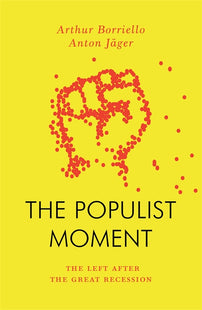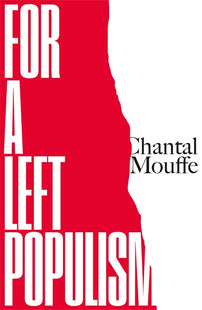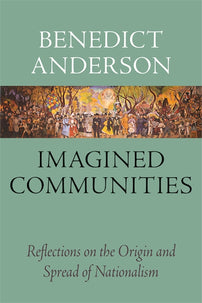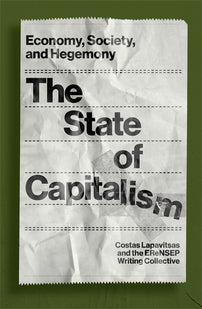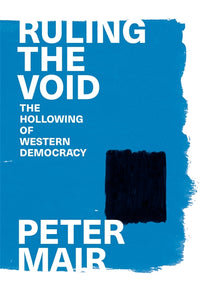The Populist Tactic
"The internet has simply exacerbated the pre-existing trends of the neoliberal period. But at the same time, the internet is not solely a means of communication. It is a social form—a type of association or community, or a machine to generate 'imagined communities.'"

On April 6, 2022, the French politician Jean-Luc Mélenchon appeared on stage at a rally in Paris. Or rather, Mélenchon himself did not appear: instead, an immaterial image of the French party leader was beamed onto the stage, after which the audience in several cities listened to a speech from the ether. As with his run five years before, Mélenchon had decided to appear as a hologram rather than in the flesh, allowing outreach to a wider circle of sympathizers.
Mélenchon’s stunt nodded to an essential feature of the left populist experience in general—its newly digital dimension. This shift not only changed the fundamentals of membership in the organizations in question (trade unions, political parties, and civic organizations), in which the line between members and non-members became more diffuse. It also radically altered the dynamics of campaigning, vote-bidding, and base-building upon which left parties had classically relied. As a social form, the internet was still relatively new when the protest waves of the 2008 crisis took off, for all the Arab Spring’s baptism as the first “Facebook revolution.” By the mid-2010s, however, it had already acquired maturity as a social form and was being used by forces across the spectrum.
The preconditions for this approach were also clear. The extreme marketization of society that defined the 1980s and 1990s made the West uniquely vulnerable to the perils of social media. The disbanding of voluntary organizations, the decline of Fordist job stability (and with it, mass trade unionism), the dwindling of religious life, the evaporation of amateur athletic associations, the “dissolution of the masses” and the rise of a multitudinous crowd of “individuals”—all were forces that generated a demand for social media long before there existed a product like Facebook to supply the consumer. Social media could only grow in a void not of its own making. Social media was thus both an expression of the crisis of the social that predates the internet and a potent accelerator of that crisis. In the first sense, the internet has simply exacerbated the pre-existing trends of the neoliberal period. But at the same time, the internet is not solely a means of communication. It is a social form—a type of association or community, or a machine to generate “imagined communities.” Any sociologist and philosopher will tell you that we can’t separate those two components, of course, and that every new means of communication will spawn its own communities (of reading, say, or the “imagined communities” which historian Benedict Anderson saw as central to his “print capitalism”). Instead, the turn to the digital could also be understood within the frame of the crisis of civil society which the political scientist Peter Mair called the “void.” On the one hand, the online thrives off the atomization inflicted on society by the neoliberal offensive in the 1980s and 1990s. More and more, it has become the substitute association for a world in which all associative units have been eroded. (There is ample research showing strong correlations between declining civic commitment and broadband access.) At the same time, the internet accelerates and even entrenches this atomization. In this sense it is hardly a substitute for the older types of civic association we knew from the twentieth century. The exit and entry costs online of our new, simulated civil society are extremely low.
The internet is the ideal exit option for a general “exit society”— allowing people to make their “voice” heard, in Albert Hirschman’s sense, while always keeping open the possibility for citizens to drop out and check out. The stigma that comes with leaving a Facebook group or a Twitter subculture is minor compared to having to move out of a neighborhood because you scabbed during a strike. The internet did generate communities, of course, from meme groups to cookery sites. Yet the thickness and density of previous associations—to call them “voluntary” seemed misleading—was nowhere to be found online.
This porousness complicated any left-populist use of digital media. In many ways, the online environment proved a thankfully cheap way of mobilizing interest and drawing in supporters. But cheap entry costs translated into cheap exits. The 100,000 who joined Momentum had little but online mailing lists and Twitter accounts to sign up for; the voting mechanisms by which they exercised power were notoriously opaque. The same held for the email lists from which members of La France insoumise vanished unexpectedly—unsubscribing was an easier way to disaffiliate than relocating from a red municipality. In the case of Podemos, the online portals could not hide the party’s reliance on an older cadre of activists, a mainstay of radical left outfits since the 2000s.
Populism’s digital parties clearly sought to remedy the top- down dynamics of the mass party model. Yet digitization brought with it its own hierarchies, like the informal appropriation by select figureheads who ran the media debates. In Corbyn’s case, this meant that the lines between the inside and outside of the party were increasingly blurred. Anything resembling democratic centralism—in which internal party matters would first be decided in closed circles and a tight party line would be maintained externally—was a distant dream for this approach. Instead, from Bernie-boosting professional posters to the digital crowd behind Mélenchon, many left-populist questions ended up being discussed somewhere between party and public sphere, with the two often bleeding into each other.
[book-strip index="1"]
The Populist Crowd
“Against Modernization” is hardly the worst slogan for old-style left parties. Much like the “ultra” faction of hardline soccer fans, many activists of these parties would rather lose the next twenty elections than give up on their community, values, and rituals. When life-long communist militants brought their red flags to a demonstration, a Proustian feeling overcame them. They naturally observed the new digital activism, “gaseous” movements, and “beyond left and right” slogans with a sense of deep suspicion: even if they admitted that such novelties might bring visibility and resources to their club and greatly increase its chances of winning, they would never trade their certainties for those possibilities. They would keep on support- ing their home club regardless of its performance (al di là del risultato, or “regardless of the result,” as the famous slogan by SSC Napoli’s ultras put it).
Through the transformation of European party politics in the last thirty years, a striking parallel to the structural metamorphosis of the European soccer landscape emerges. Due to the sector’s growing commodification, clubs have become less and less dependent on their core fans, both financially and symbolically. Much as a steady stream of funding has driven the cartelization of political parties, the booming business of television rights has revolutionized the political economy of soccer clubs. It empowered a colluding elite whose main inter- est lies in preventing intruders from diminishing their market share: the Premier League. The old, loyal fans of local origin now began to look like gatecrashers, hampering the expansion of the club’s audience with their rowdiness and, in some cases, their hooliganism. The solution proved remarkably easy: overpriced tickets and restricted preferential access to the stadium. Soon the stands of the clubs in question would be filled by a new crowd—less local, and so with a far less passion- ate investment in the game. The atmosphere in the stadiums began to cool. Dizzying flows of money enabled the clubs to attract the best players in the world and stay competitive at the highest level. The question arose whether they even needed the unruly fans of the past.
Since the neoliberal ice age of the 1990s, most Western political parties have faced a similar temptation. The increasing fluidity of the electoral marketplace makes a catch-all strategy appealing: Why stick to the traditional fanbase when there are plenty of new potential supporters out there, not yet affiliated to a competitor? To attract them, they first lowered the barriers to entry—contrary to football clubs, indeed, here the best way to dilute the influence of old members is to slash prices rather than raise them. No need to pay a membership fee, undergo political vetting and training, or participate in endless meetings. Instead, the cheap new exit and entry costs meant members could simply click their way in and out.
This also implies a clear shift in the commercial ethics of the political club. Access to the “stadium” is no longer restricted to members : anyone is one click away from registering, starting an “action group,” and campaigning for the party candidate. Nostalgic types might find little to appreciate about this change. Yet it remains an undeniably effective strategy within the void. In a context of flagging political allegiances, increasingly fluid party systems and weaker internal discipline, it provides the populist left (or any new political contender) with an agile electoral vehicle, free from bureaucratic burdens. The method is intended to be extremely cost-effective—cheap and quick politics. It allows politicians to create ad-hoc battle machines custom-built for the conquest of executive power at the national level in record time, based on a minimal set of principles to which people can sign up easily. Such was the ambition of Sahra Wagenknecht when she left Die Linke and founded Aufstehen (Get Up), following the lead of her French neighbor Jean-Luc Mélenchon. The trick is now being performed across the politi- cal spectrum: on the left (La France insoumise), by liberals or the radical center (La République en Marche, Italia Viva), or by “non-ideological” forms of populism (Movimento Cinque Stelle, Pirate Party). Those electoral machines celebrate their distance from the traditional political families, right down to their very name.
None of them ever refer to a precise ideological and historical tradition, but rather point to some generic attitude or value (“disobedience,” “standing,” “alive,” “moving,” “we can,” “momentum,” etc.), vague enough not to foreclose any new support. Just as the mass party remained the default form of politics in the Fordist era, the “digital party,” “party movement,” or “platform party” always worked as the political twin of the start-up company. This faster politics—a sort of collage using the leftovers of the traditional political families as its raw material—has proven extremely efficient in at least one case: in a context marked by the simultaneous collapse of the center-left and center-right, and with the help of benevolent media coverage, Macron’s hollow shell (LREM) proved the ideal vehicle for driving the candidate to two consecutive electoral successes.
[book-strip index="2"]
Even when it did not lead to outright victories, as in Macron’s scenario, this new “business model” has reversed a three- decade-long trend: the hemorrhaging participation rate in traditional parties. At their peak, the left-populist start-ups could boast respectable membership numbers: in 2017, Podemos and LFI claimed between 500,000 and 550,000 registered members, which, while lagging way behind the good ol’ mass parties of yesterday, nonetheless placed them far ahead of national competitors. Even in a much more traditional party such as Labour, membership rates ballooned under Corbyn—doubling between 2014 and 2015, reaching a peak of 564,000 registered fee-paying members in December 2017 (which made it the largest party in Western Europe at the time) before reverting to a slow but steady decline. While golden-age membership numbers were still out of reach—in 1952–53, Labour hit no less than a million members—the figures marked a clear break from New Labour complacency. One conclusion seemed undeniable. Left populists had successfully mobilized a massive reserve army to campaign for them during election season. They did so by radically lowering the barriers to entry, multiplying incentives for cheap affiliation, and blurring the line between members and non-members.
This produced some tangible results. When positioned as outsiders, their organizational experiments and the rebirth of militancy they fostered were premised on a sharp critique of traditional political parties, which they cast as antidemocratic, ossified, and subject to bureaucratic capture. They targeted the contemporary “iron law of oligarchy,” according to which political parties tend to develop an internal aristocracy made up of highly active militants, insiders who stand in the way of newcomers and whose raison d’être is their own self-preservation, thus leading to a certain bureaucratic stasis—a defect which Podemos figurehead Pablo Iglesias typified as the left’s “senile disorder.” Against these tendencies, the new political challengers, including left populists, have come to harbor strong antiparty sentiments and to produce a narrative articulated around the democratic benefits of online collective deliberation. The web, they announced, had finally provided the technical means to organize collective action and discussion between equals on a mass scale. It was the democratic tool par excellence, dooming the intermediary layers of the parties’ bureaucracy to natural obsolescence. To varying extents, all left-populist contenders have espoused such an antimediation narrative—even if some of them have, like Podemos, proposed a hybrid model rather than a complete rejection of the classical form of party organization. In that regard, they were all children of their era.
The participatory limits of this model swiftly revealed themselves. The coalition of actors involved in the local groups was often particularly diverse and fragile. Left populism’s catch-all approach brought together people who would not willingly participate in the same political organization over the long haul. As one local militant told us in an interview, her “action group” in La France insoumise was a disorderly affair—where authentic leftist militants were campaigning alongside right-wing conspiracy theorists—only held together by the prospect of Mélenchon’s election. In addition, most of the newcomers maintained a relatively low level of involve- ment, thus rendering the rebound in membership and participation fragile in all the cases under scrutiny. Just one year after Keir Starmer climbed to the top of the mast at Labour, party membership had dropped by a fifth. Two years after the 2017 French presidential election, La France insoumise ’s rank and file had been decimated, as the movement counted 60,000 members. It was as easy to get out as it had been to get in. The same sixty-six-year-old communist activist who praised Mélenchon’s oratory skills bitterly regretted that, when he started to have doubts about LFI’s line, all he had to do was to “unsubscribe” from the mailing list. Afterward, no one ever inquired into his reasons for leaving. Moreover, in the absence of a verifiable list of fee-paying members, the figures claimed by these parties were often misleading. It has been estimated, for instance, that La France insoumise ’s “action groups” were significantly smaller than declared and that only 25 percent of them were genuinely active, which would divide the official census by ten (from 60,000 to 6,000). In Podemos, less than half the sympathizers were deemed to be active. Finally, the introduction, in 2020, of a three-euro fee to be registered to the local circles revealed the true number of properly militant podemitas: around 19,000.
This problem was only compounded by the diffuse command structure of many left-populist outfits. Although they claimed to have abolished the distinction between core militants and mere sympathizers—no privileges were granted to the former—hierarchies soon asserted themselves. In fact, research has repeatedly proved that the gap between members and voters persists: the former are still more likely to be men, with a higher level of education and a better employment status than the latter. Among members too, de facto hierarchies returned, as the different levels of activism progressively divided the core militants from more sporadic participants. Functioning as a swarm, where atomized individuals play their part in a common strategy decreed by an unmentioned queen bee, this kind of political formation must rely on the work of “super-volunteers” to compensate for the lack of permanent staff. As Bernie ’s advisors had it in their blueprint, “The revolution will not be staffed.” Such informality often implies a real risk of exacerbating rather than decreasing inequalities among activists; that is, between those who can afford full-time voluntary activism and those who cannot. The annals of LFI are full of testimonies along these lines. Charlotte Girard, a central figure of the 2017 campaign and wife of Mélenchon’s late right-hand man, François Delapierre, openly criticized the lack of adjustment for a full-time working single mother eager to play an important role in the organization. Others lamented the “Parisianism” of the movement. LFI’s “super-volunteers” thus became a sort of new internal oligarchy, far more active than the large mass of apathetic, “lurking” supporters, sporadically active in online consultations at best. The research is indisputable: the dream of online collective deliberation never materialized. Rather, it rapidly turned into a new plebiscitary model. Most of the online consultations amounted to a form of “pseudo-participation” that “almost invariably ended with supermajority splits in favor of the line chosen by the leadership.”
All in all, these attacks on the very idea of mediation aggravated the issues of representation which left populists first set out to solve. It implied overinvestment in the “war of movement,” the use of organizational and communicational shortcuts to conquer executive power as if by surprise. This was to be achieved through electoral blitz and digital agitprop, which failed to address the terrifying complexity of the issues facing socialist governments. By insisting on a strict equation between power and electoral returns, left populists were bound to end up prioritizing form over content and quantity over quality. The return to politics they pushed for, understood as a performance of antagonism, tended to hollow out the policy content they endorsed. It set aside the crucial issues for later: how to escape from the EU’s fiscal bite? How to reconcile working-class and middle-class views on environmental issues? How to deal with claims for regional autonomy? Many left populists were short of any clear answers to these questions. For classical socialism, the commitment to internationalism at least offered a generic way of dealing with national issues.
Lacking this asset, left populism was destined to run into the same obstacles over and over again: to indulge in the same fascination as neoliberals for technocratic fixes, and to accentuate the current disjunction between the realms of politics and policy. Indeed, some scholars have argued that populism and technocracy share a natural complicity.
This haphazard collage is hardly a replacement for solid party structures. While avoiding the traps of bureaucratic immobilism is certainly commendable, the aversion toward sturdier political organization might soon backfire. Left populists have, so far, failed to build long-lasting loyalties among their militants and voters. Instead, they have mostly settled for passive and superficial bonds with their constituency, which accommodate rather than subvert the neoliberal order. This start-up approach also carries risk. Except for (rare) moments of profound dislocation (such as the one that occurred in the wake of the subprime crisis), it could simply fall flat. The parallel fates of the movements hubristically set up by Matteo Renzi (Italia Viva) and Íñigo Errejón (Más País), condemned to marginality after they left their respective parties (Democratic Party and Podemos), are telling in this regard—it was exceedingly difficult to summon a political force out of the blue with little but a well-oiled PR machine. Through its excessive reliance on electoral payoffs and digital engagement, they run the risk of becoming the victims of the same volatility that brought them into the spotlight in the first place. Without laying foundations in society, they might turn out to be little more than a flash in the pan, extinguished by the next blast of wind—a scenario that almost became reality for the Italian Five Star Movement. Without entrenching the party into coherent voting blocs, without recreating social bonds and a specific subculture, without providing the popular sectors with a crucible in which to build a collective view of society, and without training a new generation of cadres beyond the star player—in sum, without waging a war of position to consolidate the gains of the digital vanguard—left populism will be remembered as little more than a wasted opportunity.
[book-strip index="3"]
